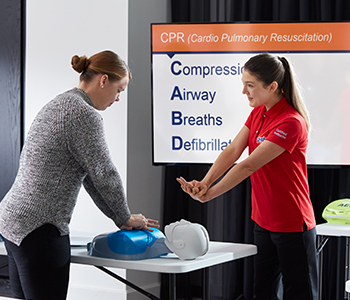What is CPR and AED Training?

CPR and AED training teaches you the skills to help someone who may be suffering from a life-threatening cardiac or breathing constriction event.
So what’s the difference between CPR and AED Training?
The primary aim of CPR is to get blood moving to vital organs when the heart stops beating. Meanwhile, an AED is a machine that attempts to restart the heart through an electric shock, if the person is suffering from sudden cardiac arrest and the AED detects certain irregular electrical signals from the heart.
CPR and AED training are commonly part of general First Aid training, which teaches you how to respond to medical emergencies before EMS arrives on the scene.
Cintas offers CPR and AED training courses at your workplace, at local Cintas First Aid training facilities or a blend of online/on-site learning.
What do CPR and AED stand for?
CPR stands for Cardiopulmonary Resuscitation. It’s often administered during a heart attack or near drowning. CPR training involves teaching the proper techniques for chest compression, opening the airway and helping a victim breathe.
AED stands for Automated External Defibrillator. An AED is a machine that can restart the heart through an electric shock. Many worksites and public places have AED machines, and they are often used in conjunction with CPR.
AED training teaches students how to use an AED, assess a victim’s consciousness and breathing, prepare them for a shock and deliver it.
Types of CPR and AED Training
There are several different types of CPR and AED training, including courses for the general population and for healthcare providers. There are also training classes for people who work with children and infants.
Types of American Heart Association CPR and AED training courses include: [1]
Heartsaver® courses -- Designed for “anyone with little or no medical training who needs a course completion card for job, regulatory (for example, OSHA), or other requirements.” These courses are open to the general public.
Healthcare Professional courses -- Training reinforces healthcare professionals' “understanding of the importance of early CPR and defibrillation, basic steps of performing CPR, relieving choking, and using an AED.”
Heartsaver® Pediatric First Aid CPR AED -- Teaches students to respond to and manage illnesses and injuries in a child or infant and is designed for childcare workers.
Benefits of CPR and AED Training
CPR and AED training can help save lives. Quick reaction in the first minutes of a medical emergency can mean the difference between life and death. CPR and AED training isn’t meant to replace Emergency Medical Assistance, so you should always call 911 in an emergency.
However, administering proper CPR and AED techniques can make a difference.
There were approximately 350,000 cardiac arrests outside of hospitals in 2016, according to the American Heart Association. Nearly half, 46.1 percent, were administered CPR with a 12 percent overall survival rate. [2]
Recent studies have shown that bystander CPR combined with effective defibrillator use more than triples a cardiac arrest victim’s chance of survival. [3]
[1] https://cpr.heart.org/AHAECC/CPRAndECC/Training/HeartsaverCourses/UCM_473174_Heartsaver-Courses.jsp
[2] http://cpr.heart.org/AHAECC/CPRAndECC/General/UCM_477263_Cardiac-Arrest-Statistics.jsp
[3] http://circ.ahajournals.org/content/131/4/e29